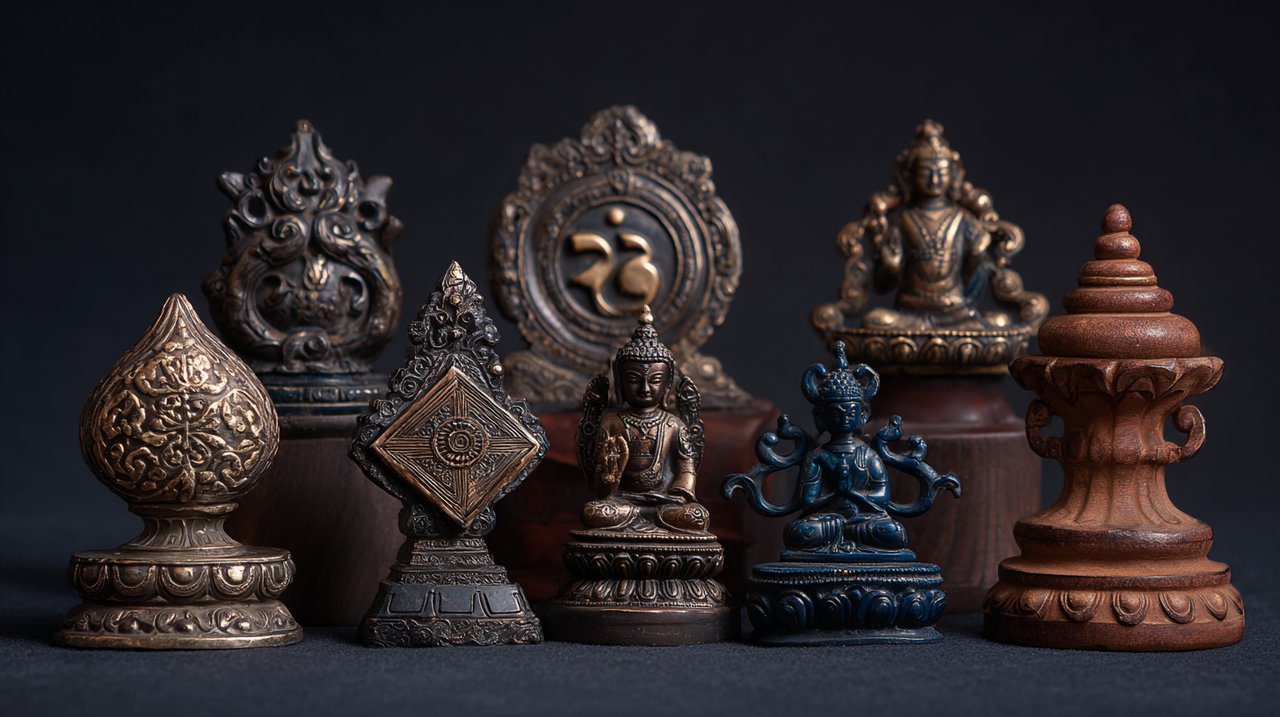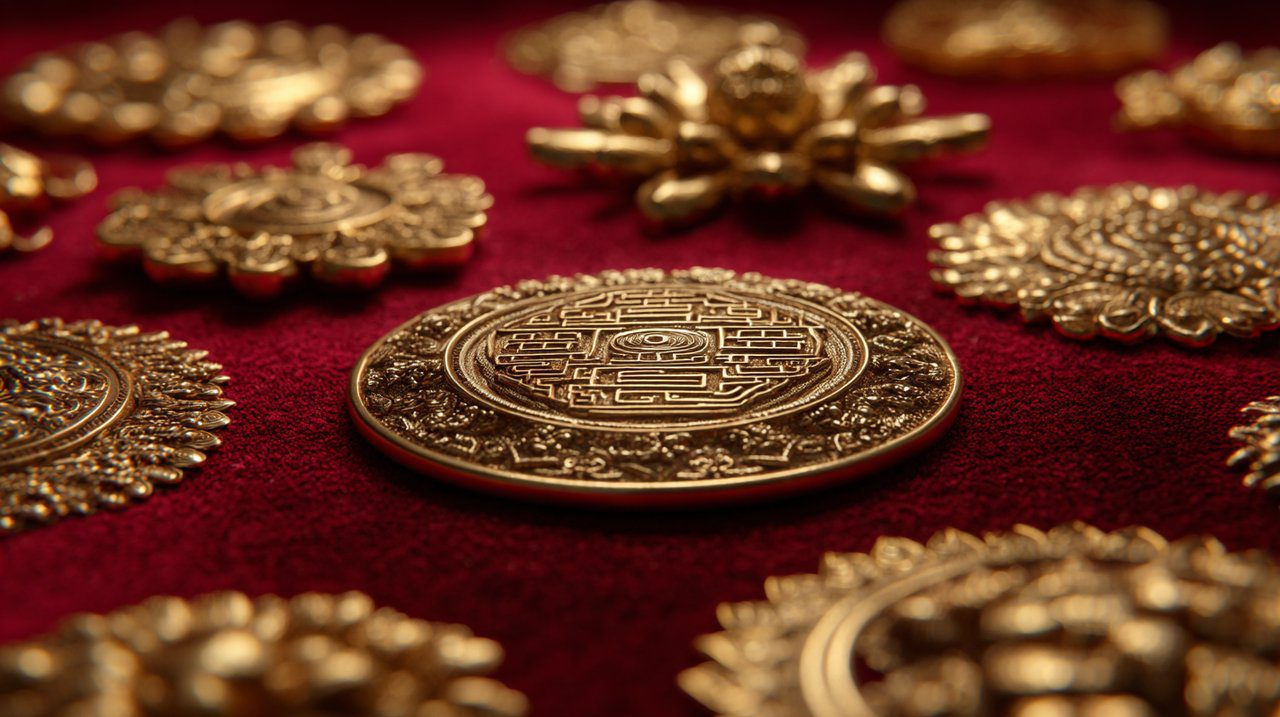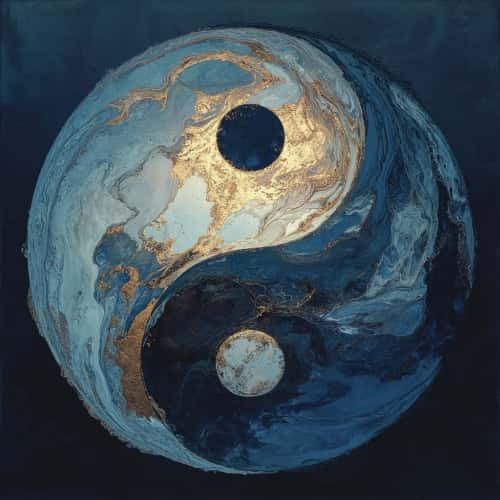Tibetan Symbols and Meanings: Your Guide to Their Spiritual Power & Practical Applications
Have you ever wondered if the true power of ancient symbols comes not from magic, but from something much closer to home: our own minds? As a curious student of feng shui, I’ve always viewed these powerful emblems, especially those from Tibetan Buddhism, as a sophisticated form of environmental psychology or a system for positive affirmation.
They’re far more than just beautiful designs. These symbols are ancient wisdom, distilled into potent visual cues. They act as powerful reminders and amplifiers for our intentions, gently guiding us toward protection, prosperity, and a deeper sense of self.
Deconstructing Their Power: The “Why” Behind Tibetan Symbols’ Influence

When we first encounter Tibetan symbols, it’s easy to be captivated by their intricate designs. But their true power, I’ve come to believe, stems from how they interact directly with our minds. It’s less about mystical forces and more about the fascinating way our brains process visual information and reinforce our deepest intentions.
Symbols as Visual Anchors: Psychology of Intention
Think of a symbol as a visual anchor for a specific intention or desired state. It’s much like how a bright yellow crystal can serve as a constant reminder to focus on optimism and financial goals. A Tibetan symbol functions similarly, but often for spiritual qualities or life aspirations.
The consistent presence of a symbol repeatedly directs our thoughts and energies towards its associated meaning, strengthening our resolve and focus.
This isn’t magic; it’s a profound application of repeated exposure and self-suggestion. For instance, regularly seeing the Endless Knot can subtly reinforce your understanding of interconnectedness in your daily life, making you more aware of how everything is linked.
Cultural Resonance and Collective Consciousness
These symbols aren’t created in isolation; they’ve been woven into the fabric of a culture for centuries, carrying layers of shared meaning. This cultural resonance means they tap into a collective understanding that’s deeply embedded within the Tibetan tradition.
When you engage with these symbols, you’re not just connecting with a personal belief. You’re tapping into a vast lineage of individuals who have imbued them with similar intentions and significance. This shared history amplifies their psychological impact, making them even more potent.
The Eight Auspicious Symbols: An Ancient Blueprint for Life Wisdom

The eight auspicious symbols are arguably the most recognizable and foundational set in Tibetan Buddhism. Each one beautifully represents a key aspect of an enlightened mind and beneficial life outcomes. Together, they offer a profound framework for navigating life’s journey.
Decoding Each Symbol’s Practical Philosophy
Let’s dive into how each symbol, from a practical and psychological standpoint, can serve as a powerful prompt for personal growth:
- Conch Shell: This represents the resonant sound of the Dharma, awakening us from ignorance. Psychologically, it acts as a call to clarity and mindful communication, encouraging us to speak and listen with intention.
- Endless Knot: Symbolizing the interconnectedness of all phenomena and infinite wisdom, this knot encourages a perspective of unity and the profound impact of karma. It reminds us that everything is linked.
- Pair of Golden Fish: Representing freedom from suffering and abundance, these fish are a vibrant visual cue for joy, fertility, and prosperity. They encourage a mindset of flow and ease.
- Lotus Flower: A powerful emblem of purity, spiritual awakening, and compassion. The lotus grows unstained from mud, beautifully reminding us of our own capacity for resilience and transformation, no matter our circumstances.
- Victory Banner: This symbol signifies the triumph over obstacles and ignorance. It’s a fantastic visual to inspire perseverance and achievement, especially when facing challenges.
- Vase of Treasure: Representing infinite wealth, longevity, and spiritual fulfillment, the vase promotes a mindset of abundance and contentment. It helps us focus on what we have, not what we lack.
- Dharma Wheel: This wheel symbolizes the teachings of the Buddha and the cycle of rebirth. It encourages deep understanding and consistent spiritual progress, urging us forward on our path.
- Precious Umbrella: Offering protection from harm and negative forces, this symbol psychologically fosters a deep sense of security and inner peace. It’s a reminder that we can shield ourselves from negativity.
Integrating the Eight Auspicious into Daily Practice
Bringing these symbols into your everyday environment can be a truly powerful practice. You might choose to place them strategically in your home or office, allowing them to serve as gentle, yet potent, reminders of your deepest aspirations.
For example, consider displaying the Victory Banner as a daily affirmation when you’re tackling a challenging project. Or, place the Golden Fish where you conduct your financial planning; it can become a strong focal point for your financial intentions, helping you visualize and attract prosperity.
Beyond the Core: Other Significant Tibetan Buddhist Symbols and Their Unique Roles
While the eight auspicious symbols form a powerful core, the broader world of tibetan buddhist symbols offers an even richer array of specialized tools. Each carries a distinct intention and purpose, serving as a guide for specific aspects of our personal growth.
Dzi Beads: Ancient Amulets and Prosperity Markers

Dzi beads are truly fascinating. These ancient agate beads, often distinguished by their unique “eyes,” are highly revered in Tibetan culture. Traditionally, they are believed to offer robust protection and attract good fortune.
From a psychological standpoint, wearing a dzi bead acts as a potent personal affirmation of security and success. It creates a tangible link to ancient wisdom, powerfully reinforcing a belief in your own resilience and potential for prosperity. It’s like carrying a quiet but firm vote of confidence with you.
Tibetan Prayer Wheels and Mala Beads: Tools for Focused Meditation
Tools like tibetan prayer wheels and mala beads are specifically designed for active engagement. Prayer wheels contain written mantras, and turning them is said to accumulate merit. Psychologically, this repetitive, rhythmic motion can be incredibly calming and meditative, significantly aiding focus and mental clarity.
Similarly, mala beads (Tibetan rosaries) are used for counting mantra repetitions during meditation. The tactile sensation of each bead and the rhythmic count work together to anchor the mind, preventing distractions and deepening concentration. It’s a very practical, hands-on method for training your attention.
Tibetan Jewelry: Wearable Affirmations and Personal Empowerment
Many pieces of tibetan jewelry beautifully incorporate these powerful symbols. Wearing a pendant featuring an Endless Knot or a ring with the Dharma Wheel isn’t just about adornment.
It’s a form of wearable affirmation. Keeping the symbol’s meaning physically close to you subtly influences your thoughts and actions throughout the day. This personal connection reinforces your intentions and empowers your self-belief, making your aspirations a constant, gentle presence.
Practical Application: Using Tibetan Symbols in Modern Life
Understanding the “why” behind these symbols truly unlocks their potential for us. They aren’t just fascinating artifacts; they are active, practical tools we can use for personal development in our everyday lives.
Cultivating Inner Peace and Mindfulness
To foster a greater sense of peace, consider placing a Lotus Flower symbol in your meditation space or a quiet corner of your home. Its presence can serve as a visual cue for purity and serenity, gently guiding your mind toward calm.
Engaging with a prayer wheel or mala beads during moments of stress also offers a structured way to return to the present. The rhythmic, focused action itself is a powerful mindfulness practice, helping to quiet the mental chatter.
Attracting Abundance and Positive Energy
If you’re looking to cultivate more abundance, the Vase of Treasure or Golden Fish symbols can be incredibly powerful visual reminders. Try placing them where you do your work or financial planning.
They act as a constant prompt to cultivate an abundant mindset, shifting your focus toward opportunities and growth rather than scarcity. This mental alignment is often the crucial first step toward manifesting prosperity in your life.
Enhancing Protection and Well-being
For an enhanced sense of protection and security, the Precious Umbrella symbol is ideal. Keep it near your entrance or in your personal space. It functions as a psychological shield, reinforcing your sense of safety and resilience.
Similarly, wearing dzi beads or other protective tibetan jewelry can instill a tangible feeling of being safeguarded. This inner sense of security can significantly contribute to your overall well-being and confidence.
By approaching Tibetan symbols with this de-mystified, rational lens, we truly uncover their profound potential. They reveal themselves not as magical talismans, but as sophisticated psychological and spiritual tools. They offer us a tangible way to anchor our intentions, cultivate positive mindsets, and connect with ancient wisdom in a deeply personal way.
Ultimately, these symbols aren’t about magic; they’re about empowerment. They provide a clear framework for focusing our minds and shaping our environments to support our deepest desires—for protection, prosperity, and self-discovery. So, why not begin to explore how these ancient tools can enrich your own journey and bring more “aha!” moments into your life?
💡 Häufig gestellte Fragen
Tibetan symbols are believed to be effective not through magic, but through their interaction with our minds. They act as visual anchors for specific intentions or desired states, similar to how a bright crystal might remind you of financial goals. The repeated exposure to these symbols reinforces our thoughts and energies towards their associated meanings, strengthening our resolve and focus through a process of repeated exposure and self-suggestion.
Each of the Eight Auspicious Symbols offers a practical philosophy for personal growth. For example, the Conch Shell encourages mindful communication, the Endless Knot promotes a perspective of unity and karma, and the Lotus Flower reminds us of resilience and transformation. The Victory Banner inspires perseverance, the Vase of Treasure fosters abundance, the Dharma Wheel encourages spiritual progress, and the Precious Umbrella promotes a sense of security and inner peace.
Dzi beads, with their 'eyes,' act as potent personal affirmations of security and success, linking wearers to ancient wisdom and reinforcing resilience. Tibetan prayer wheels and mala beads are tools for focused meditation; the repetitive, rhythmic motion of prayer wheels aids focus and mental clarity, while mala beads anchor the mind for deeper concentration during mantra repetitions.
Tibetan jewelry that incorporates symbols like the Endless Knot or Dharma Wheel serves as wearable affirmations. Keeping the symbol's meaning physically close influences thoughts and actions throughout the day, subtly reinforcing intentions and empowering self-belief by making aspirations a constant, gentle presence.
Integrating Tibetan symbols can foster inner peace and mindfulness through visual cues like the Lotus Flower, or structured practices with prayer wheels. To attract abundance, symbols like the Vase of Treasure or Golden Fish act as reminders to cultivate an abundant mindset. For enhanced protection, the Precious Umbrella or Dzi beads psychologically reinforce a sense of safety and resilience, contributing to overall well-being and confidence.








